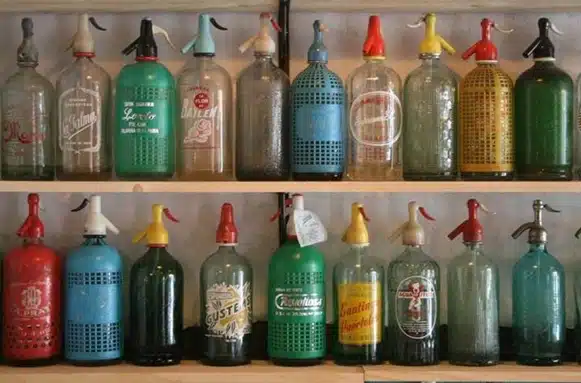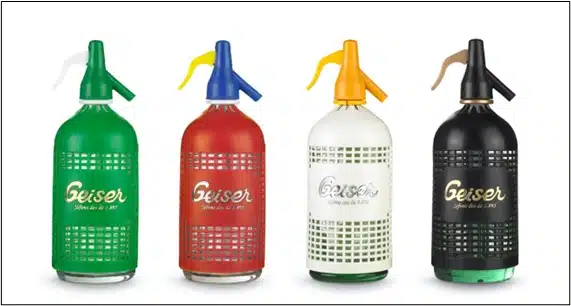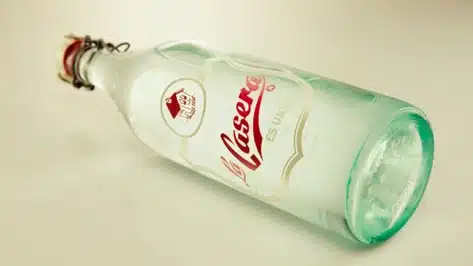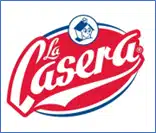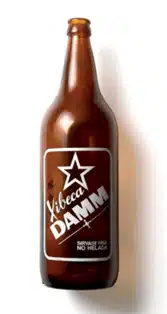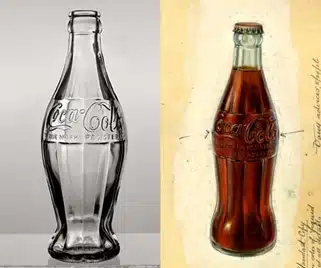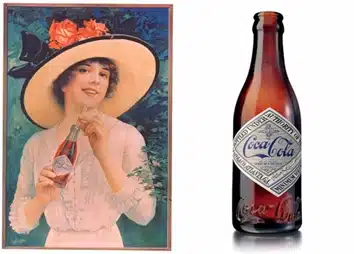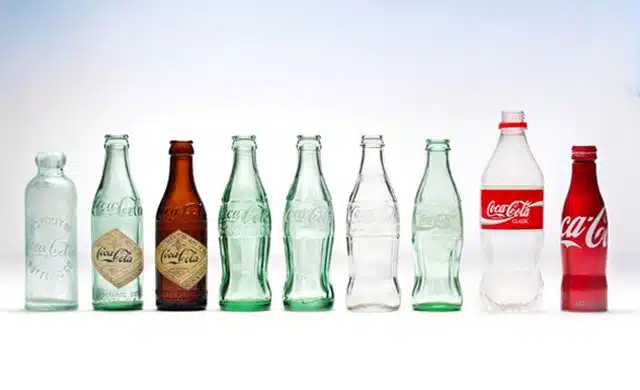
15 Sep 4 historical bottles
Index of contents:
- Bottle evolution: from container to brand value
- Geiser Sifón (siphon soda)
- La Casera Gaseosa (sweetened soda)
- Xibeca liter format
- Coca-Cola Contour
- The bottles of today
Bottle evolution: from container to brand value
Over time, bottles have gone from being a mere container for the product to be consumed or stored, to being an important part of the logistics process of companies, conditioning their production, handling, transport and storage operations.
But often, a beverage cult grows from emotional values that define a personality for the brand, values that are not built solely on logical reasons. Some companies have considered their bottles as an emotional element for their brand, creating authentic legends and icons of the industry.
For these brands, the bottle design was more than just a part of the container for the product being sold. It was the symbol of their value proposition with which their consumers felt identified.
Today, however, there are other priorities to be taken into account, such as sustainability, the circular economy, cost and space optimization, etc. However, there are still opportunities for differentiation and standing out thanks to companies that are passionate about innovation and design.
Here are some unique examples of bottles that have gone down in history for different reasons.
Geiser Sifón (siphon soda)
According to the Real Academia Española (RAE), “sifón” is a bottle, generally made of glass, hermetically sealed with a cap which contains a siphon, fitted with a valve to open or close the flow of the carbonic acid-laden water.
Via: La Sifonería para Guía Repsol
Beyond the RAE’s definition of this drink, siphon is part of our soft drink history and its use has marked an entire era and a flourishing industry in half the world.
Soft drinks were born more than two centuries ago, at the end of the 18th century. Many of them originated in the pharmaceutical field and were usually taken to alleviate minor ailments.
The first known soft drinks were made from natural still water or naturally carbonated waters, which were combined with fruits and sweeteners such as honey or other sweetened juices.
The first step that led to the development of modern soft drinks came at the end of the 18th century, when the term “soda” began to be used to refer to a beverage made from water, sodium bicarbonate and carbon dioxide.
Among the different kinds of soda, sour or acidic water used to be recommended for problems such as heartburn, indigestion or even gout. In turn, seltzer was used, due to its pleasant taste and its medical properties, to reduce fever, treat stomach ailments or nervous disorders.
In the first decades of the 19th century, soft drinks transcended pseudo-therapeutic uses and became commonplace in homes, becoming the ideal beverages to accompany lunches and dinners.
To meet consumer demand, manufacturers also had to adapt their packaging and distribution systems, and so they began to design bottles whose shape distinguished their product from the rest.
Sanmy is one of the companies with the longest tradition in the production of soft drinks and the oldest in Spain. Its history goes back four generations, to 1895, when the Puértolas brothers started to manufacture beverages in their first factory in Barcelona.
Francisco and Santiago Puértolas Ramón, originally from Aragón, came to Catalunya to perform their military service. Upon their discharge from the military in 1890, they started to work in a small factory that made sweetened soda (“gaseosa”) and siphon soda in Barcelona’s Calle Aribau. A few years later, they bought the factory and started their own business.
At present, they have more than 180 references and 60 brands on the market, with Geiser Sifón being one of their flagship products.
Via: Sanmy
Tras una larga historia, Sanmy ha logrado evolucionar con los tiempos y, a la vez, mantener el carácter familiar y seguir siendo una empresa embotelladora independiente.
La Casera Gaseosa (sweetened soda)
Via: Expansión
A key product and pioneer in the history of soft drinks in Spain has been “gaseosa” (a sweetened soda). This beverage, which led the market for years, has been present –alone or in combination with others– in the daily lives of the Spanish people for more than a century.
It began to be manufactured on a large scale at the beginning of the 20th century and became even more popular in the 1950s. At that time, there were countless brands, very local and artisanal, until 1949, when La Casera was born, which would become the first major national soda brand.
They were transparent glass bottles that conveyed a feeling of cleanliness and hygiene, allowing the product to be seen, and they were closed with a mechanical cap with a porcelain head, instead of the traditional cork closure.
To make housewives aware of the product, a deliveryman on a three-wheeled bicycle gave away bottles in the neighborhoods. The housewife kept the empty container and if she wanted a new one, she would have to pay 1.20 pesetas, a luxury in those days.
In addition to the original half-liter bottle, new orange and lemon flavors were created, making it the family soft drink par excellence for several decades.
Via: Cinco Dias/El País
During the 80’s a hostelry line was created based on the well-known phrase “if they don’t have Casera, we’re leaving”, a slogan that is still remembered to this day, and during the 90’s and the turn of the century it continued to adapt to consumer tastes by expanding its line of flavors.
Xibeca liter format
Via: Cocina con poco
Despite the clichés and the climate, the relationship of the Spanish people with beer is much less fluid than that of our Central European neighbors. Spain is a more than solvent manufacturer of beer, but this derivative of barley competes on our tables with a historical product like wine and, to a lesser extent, with vermouth, cava or even cider. According to the Statista data portal, Spain ranks 22nd in Europe in terms of beer consumption, with 52 liters per person, far behind the leading positions of the Czech Republic (142 liters), Austria (107 liters), Germany (100) and Poland (98).
Industrial beer production in Spain began in 1856 in Barcelona, thanks to what was officially the first Spanish industrial brewery, Moritz, founded by the Alsatian Louis Moritz Trautmann. Not long thereafter, in 1876 and also in Barcelona, Damm was founded by a fellow countryman, August Kuentzmann Damm. Madrid was also not excluded from this trend, and in 1890 the Frenchman Casimiro Mahou founded his company, Cerveza y Fábrica de Hielos (beer brewery and ice factory), obviously the forerunner of the current Mahou-San Miguel group. Curiously, that same year, more than 11,500 kilometers away, the other partner that lent his name to the group was born, since San Miguel was founded by the businessman Enrique María Barretto in Manila (Philippines) during the Spanish domination.
Each community in Spain is a world all by itself with its own customs and preferences, wherefore a Madrilenian will not necessarily drink the same brand as a Galician, since the territory is very divided geographically, thanks to the factory effect that has historically facilitated the distribution of this drink.
Xibeca or Xibeca-Damm emerges as a recognized beer brand, brewed in Barcelona and Mallorca for local enjoyment, under the umbrella of SA Damm. Its majority presence is in the national market. This Pilsner-style lager beer has a pale hue and moderate alcohol content (4.6°) and is commonly distributed in a one-liter format, accentuating its affordable price. Conceived in the late 1960s, the “Xibeca” label emerged as an alternative to red table wine, the cost of which was rising during that period. This drink gained notorious popularity in the 1970s, especially in the Catalan region.
It is an almost centenary brand that changed drinking habits in our country and managed to introduce the consumption of beer in the family, thanks to its packaging and flavor.
Coca-Cola Contour
The Contour bottle exactly as it was designed originally (left) and after its restyling for mass production.
Via: Coca-Cola España
A different bottle to end confusion.
It all started in 1915. Coca‑Cola had been bottling its popular soft drink since the turn of the century, and it already had more than 1,200 agreements all across the United States. However, when it was about to celebrate its 30th anniversary, the company was faced with a great challenge: imitations.
Despite attempts to avoid consumer confusion with the introduction of a diamond-shaped label in 1906, at that time there were a wide variety of drinks on the market with similar names born in the heat of Coca Cola’s success: Koka-Nola, Ma Coca-Co, Toka-Cola, Koke… which even used similar logos and labels.
Via: Coca-Cola España
As if that weren’t enough, Coca Cola’s old, straight-lined bottles were usually sold chilled in tubs of cold water, so the labels peeled off easily, and since those bottles all looked very similar (and each bottler used a different one), it was difficult to distinguish Coca Cola from the competition before you took your first sip.
The solution Coca Cola’s executives came up with was one that changed the way people drink forever: launching an unmistakable bottle.
A bottle that’s recognizable in the dark
Thus, in April 1915, the Coca Cola Bottlers Association decided to invest $500 (which at the time was a lot of money) in the development of an unparalleled bottle. A total of 10 glass companies were approached with a challenge as simple in its exposition as it was complex in its execution: “to create a bottle so unmistakable that it could be recognized by touch in the dark or even broken on the floor”. In addition, it had to be label-free, as labels could come off.
The Swede Alexander Samuelson designed the Contour bottle.
Via: Coca-Cola España
The design proposed by Samuelson was the clear winner when Coca Cola executives and bottling companies met in early 1916 to choose the bottle they would use from then on, although it was agreed that the shape would be slightly stylized to facilitate production, giving rise to the design we all know and recognize today.
An economic success, but also a cultural one
The introduction of the Contour bottle was a great success for Coca Cola, which thanks to this move made its product not only very difficult to imitate, but also almost immediately recognizable by the consumer, who would instantly distinguish a Coca Cola bottle by its curves, the feel of the embossed logo or the green color of the glass, called “Georgia green” in homage to the company’s home state. Thanks to this new bottle, in 1928, sales of bottled Coca Cola managed to surpass fountain sales for the first time.
Its influence on culture has been such that many artists have incorporated it in their work. The first was Salvador Dalí, in his Poetry of America of 1943, followed by others such as Paolozzi or Rauschenberg. However, the driving force behind the Contour bottle as a pop art icon was Andy Warhol, who used it in his exhibit The Grocery Store, along with other of his main motifs such as Campbell’s soup cans.
In 1950 it appeared on the cover of Time magazine, becoming the first commercial product to do so. Originally, the magazine wanted Robert Woodruff, CEO of the company at that time, but he refused, arguing that the brand was more important and that therefore the bottle should be the protagonist.
Few have been able to avoid succumbing to its charms and many legends from the world of cinema, music, even science or politics, have posed with the bottle. Marilyn Monroe, Elvis Presley and Ray Charles appeared with this symbol of consumerism and art.
The Coca-Cola Contour bottle, more alive than ever
This is the exciting story of a bottle that was born to be unique and help fight against imitators, and which has ended up becoming an icon of our time and proof that modern industrial design can create pieces of art that respond to both a need and an opportunity.
The bottles of today
As we can see, these initial containers, which were intended to attract the attention of consumers in order to differentiate themselves from the competition, avoiding confusion, have over time moved on to more “commercial” formats.
Formats adapted to distribution, self-service sales, refrigeration chambers in bars and restaurants, domestic refrigerators, recycling, etc… with requirements capable of combining large quantities of production and consumption.
A scenario that gives a much more important role to packaging personalization through labeling. Labels, sleeves and all kinds of product identification elements now serve as a vehicle to transmit the image of many brands.
This is where Rieusset, as a specialist in label manufacturing and flexible packaging, offers all kinds of high-quality solutions in rotogravure and digital printing, to dress up those bottles and help them become part of history one day.
Do you think your product packaging projects the image you want? Would you like to improve its presentation?
If you want to achieve a distinct, unique image that makes you stand out, contact us! We are specialists in the printing of labels, sleeves and flexible packaging, with more than 150 years of experience.
| We Manufacture: | Meet Rieusset: |



